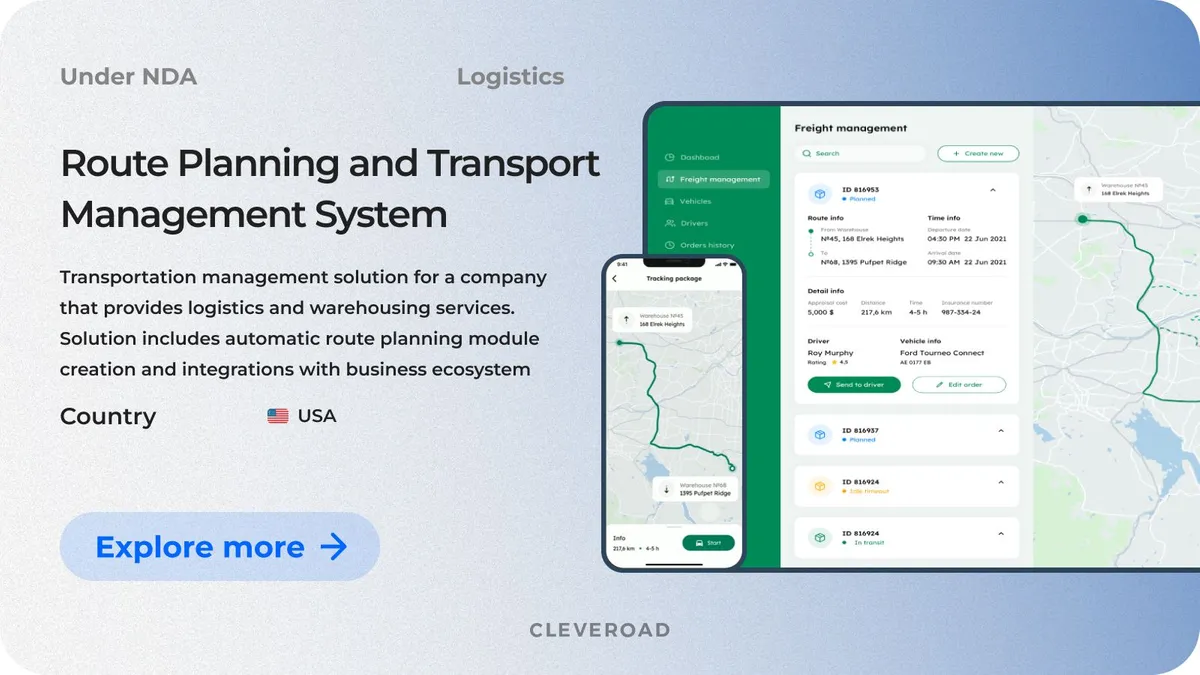How to Create a TMS Software: Features, Costs, Trends and More
Updated 05 Nov 2024
17 Min
1682 Views
Transportation management system development can bring businesses significant benefits, such as the ability to assign carriers to shipments, structure shipment management, decrease transportation costs, consolidate shipments from a centralized location, etc.
Read further to learn more about the development of this logistics system: essential features, cost, TMS innovations to use, and many more.
What Is a Transportation Management System?
Transportation management software (TMS) is a multifunctional digital tool that helps logistics and transportation businesses streamline shipping operations and optimize the overall flow. Incorporating this solution allows companies to avoid possible issues with cargo delivery delays and establish reliable logistics management operations throughout the supply chain.
Logistics processes automated by TMS
Let's find out the core TMS operations that drive the efficiency of transportation management.
- Order management: The custom transportation management system begins by receiving and consolidating orders from various sources, ensuring that all shipping details (e.g., product specifications, destination, and deadlines) are accurate and centralized.
- Route planning and optimization: Using advanced algorithms, the TMS calculates the most efficient routes, factoring in distance, traffic, fuel costs, and delivery time.
- Carrier selection: The system evaluates available carriers, considering rates, capacity, and service level to match each shipment with the best option.
- Real-time tracking: A TMS provides live tracking of shipments, giving dispatchers and customers visibility into the status and location of goods.
- Load optimization: Through load optimization, the TMS maximizes vehicle space, reducing the number of trips required and thus lowering fuel costs and emissions.
- Freight settlement and auditing: The TMS automates billing and payment by matching freight invoices with delivery records, minimizing errors and eliminating discrepancies.
- Analytics and reporting: With detailed analytics, a TMS provides insights into key metrics like transit times, costs, and carrier performance.
- Integration capabilities: A TMS integrates seamlessly with other systems like ERP, WMS, and CRM, allowing data to flow across departments and ensuring cohesive supply chain management.
By automating and optimizing these critical logistics operations, a TMS effectively improves efficiency, reduces costs, and enhances customer satisfaction.
Here is what Michael Baumann, an expert with 30+ years of working experience in transportation management, says about utilizing a transportation management solution:
Michael Baumann
Vice President at DHL Subolv Chain
Essentially, they create a transportation control tower that gives you real-time visibility of freight flows across all your operations.
Major types of transportation management systems
Whether you're considering transportation management app development or looking to optimize your logistics processes, understanding these TMS types will help you select the right solution to meet your specific needs.
On-premise TMS. Installed directly on a company’s servers, on-premise TMSs offer complete control over data and customization. This option is ideal for businesses with strict data security policies or highly specific customization needs.
Cloud-based TMS. These systems are hosted on the cloud to provide easy accessibility from any device with Internet access. Cloud-based transportation management solutions are scalable, cost-effective, and allow businesses to pay as they go, making them a great fit for companies looking for flexibility.
Third-Party Logistics (3PL) TMS. This TMS type designed specifically for 3PL providers, focuses on the needs of companies managing transportation for multiple clients. It enables seamless coordination across various client shipments, ensuring efficient scheduling, tracking, and reporting to meet each client's unique logistics requirements.
Enterprise TMS. Tailored for large organizations with complex logistics needs, transportation management system development for enterprise needs offers extensive integration options with ERP, WMS, and CRM systems. These systems are highly customizable, providing robust support for multi-location operations, diverse shipping methods, and analytics to drive data-informed decision-making.
Modular TMS. These flexible systems allow businesses to choose specific TMS modules they require (e.g., route planning, carrier management, or freight auditing) and integrate them as needed. It’s ideal for companies looking to gradually add functionality without committing to a full suite right away.
To better visualize these TMS types and their associated development costs, consider the following breakdown:
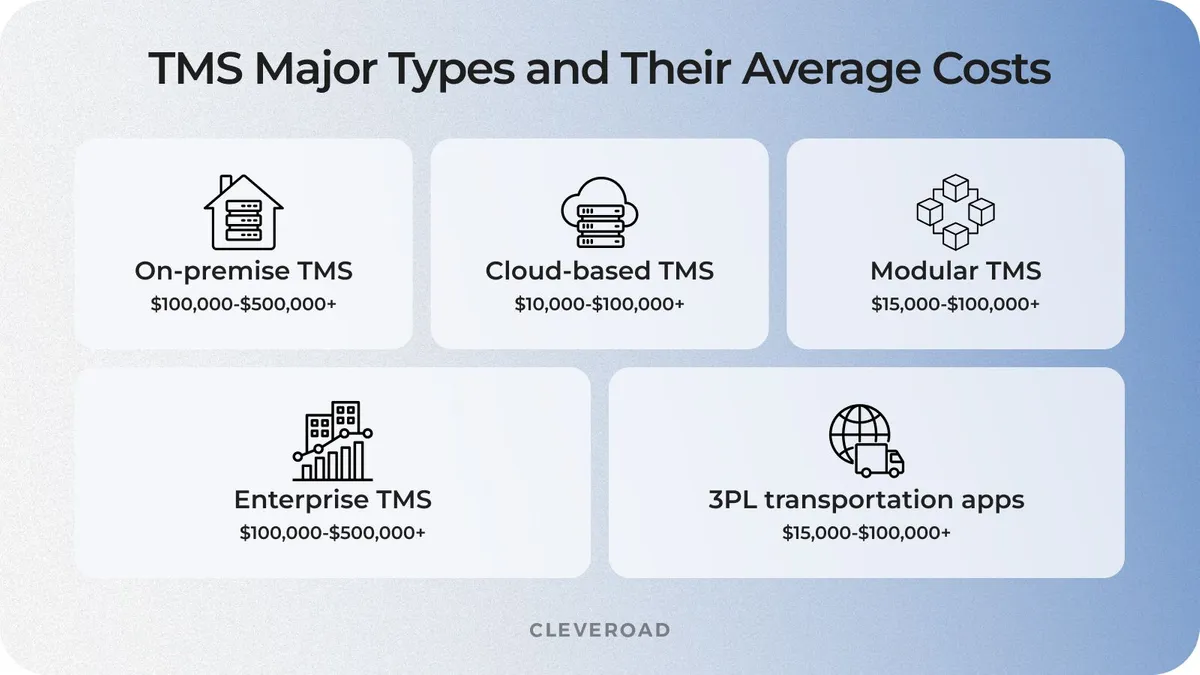
TMS major types and their average development costs
Must-Have Features For TMS Software Development
Let’s find out what features of transport management applications you require for logistics flow optimization. To make things easier, we’ve organized the features into specific modules.
TMS functionality for planning
The TMS feature set for planning should include tools to optimize routes, allocate resources efficiently, and forecast demand accurately. It often incorporates AI and machine learning to analyze past data, predict trends, and make informed decisions.
A strong planning module is essential to reduce costs and time by selecting the best routes, modes, and carriers. Additionally, planning features should support load consolidation, scheduling, and real-time adjustments to adapt to unforeseen changes in transportation needs.
Flow optimization module
The flow optimization module is a crucial aspect of transportation management software development, ensuring that shipments move seamlessly from origin to destination. It includes route optimization, dynamic scheduling, and inventory control to streamline logistics and reduce bottlenecks.
Having a focus on maximizing asset utilization, flow optimization module also helps reduce fuel consumption and carbon emissions. It improves overall efficiency by automating adjustments based on weather, traffic, or shipment conditions.
Administration module
Administration functionality focuses on the back-end operations of a TMS, providing control and visibility over billing, invoicing, and reporting. It allows businesses to manage contracts, payments, and customer accounts within the platform.
An effective administration module supports financial auditing and transparency, helping to identify cost-saving opportunities. It should also offer reporting capabilities for tracking Key Performance Indicators (KPIs) and generating insights on logistics efficiency and spending.
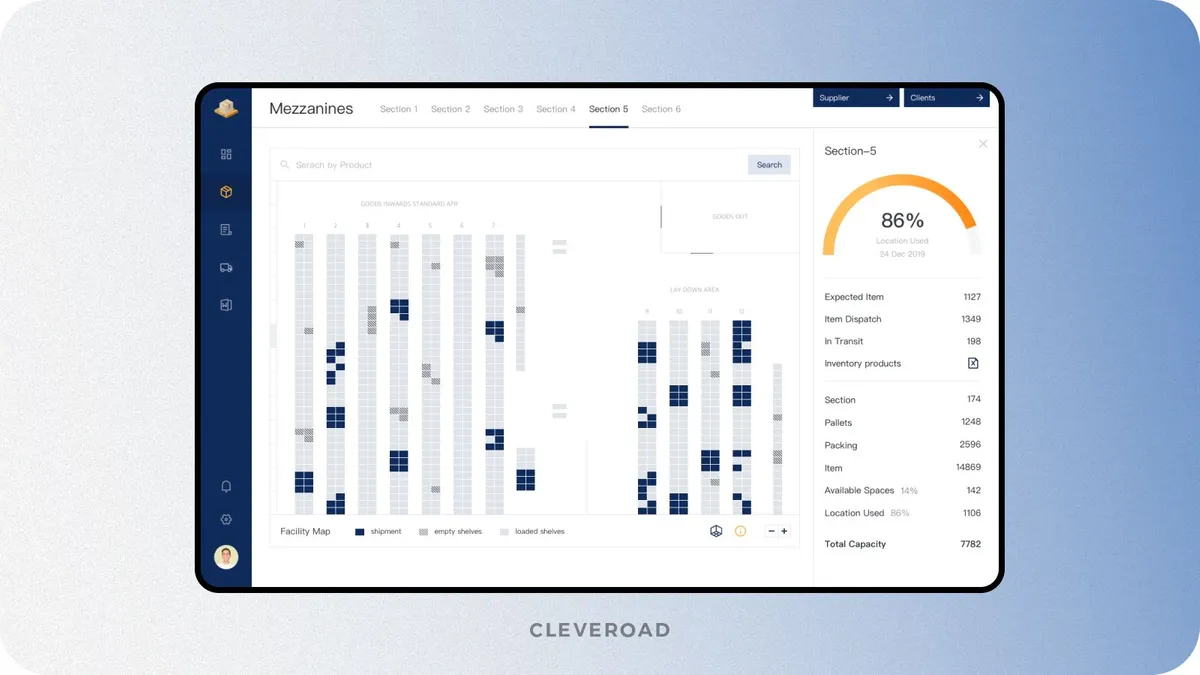
Admin panel for logistics designed by Cleveroad (source: Dribbble)
TMS execution functionality
Execution functionality in a TMS includes such transportation operations as dispatch management, load assignment, and tracking of each shipment along its route. Execution features should also ensure compliance with regulations, providing the necessary documentation and updates throughout the transportation process.
What is more, execution tools should enable seamless coordination with drivers, carriers, and customers through notifications and alerts. It may also include capabilities for exception management, allowing swift responses to any arising issues.
Integrations with other systems
Integrations with external systems are crucial for a TMS to streamline operations, improve data accuracy, and enhance decision-making capabilities.
Common integrations with a custom transportation management system include:
- Enterprise Resource Planning (ERP) system
- Warehouse Management System (WMS)
- GPS tracking
- Fleet management tools
These integrations allow for seamless data flow between different systems, enhancing visibility and accuracy across operations. By connecting with carriers and third-party logistics providers, a TMS can access real-time data on shipment statuses, rates, and schedules. Additionally, API capabilities (e.g., trucking API or API in shipping) are essential for easy connection with new or custom systems, ensuring that the TMS remains adaptable to changing business needs.
Why Consider a Custom Transportation Management System Creation?
Transport management system development streamlines, automates, and optimizes logistics operations for enhanced efficiency, cost savings, and improved customer satisfaction.
Sure enough, there are different approaches to transportation management system development. You can rely on a pre-made application or go custom. However, ready-made options may lack customization and may require even more financial investments in the future perspective. Unlike customized solutions – they seem more expensive but offer a great amount of benefits for transportation organizations.
Now, we’ll talk more about the major advantages of TMS implementation in your business.
Cost savings in the long run
Developing a custom TMS allows companies to choose only essential functionalities for their supply chain operations, avoiding the costs associated with unnecessary features found in off-the-shelf logistics software.
Custom TMS solutions are adaptable to evolving business needs, eliminating the need for new software investments. They also help avoid hidden fees related to licensing and upgrades, providing better financial predictability and control.
Furthermore, custom TMS can significantly enhance ROI by improving operational efficiency and aligning closely with logistics processes, ultimately reducing costs and improving service delivery.
Tailored to specific needs
Logistics companies often face unique requirements and operational challenges that off-the-shelf solutions may not adequately address. A custom transportation management system (TMS) is designed to integrate seamlessly into existing business environments, ensuring that it meets the specific needs of the organization.
By using a custom TMS platform, businesses can enhance their transportation plan and improve inventory management, which ultimately boosts operational efficiency. Tailored software solutions also provide seamless implementation and scalability, allowing logistics services to adapt as your particular business grows.
Moreover, custom systems deliver a superior user experience, as they are built to function accurately within the company’s workflow, reducing the risk of costly errors and additional investments. Investing in a custom transportation management system enables logistics businesses to streamline their operations and achieve long-term success.
Tailored to your needs, a custom TMS can also be developed as a mobile solution, giving your team the flexibility to manage logistics operations on the go.
How to benefit from transportation app development? Read our article and know more!
Robust security
The integration of a custom transportation management system, combined with an advanced transportation telematics system, allows tailoring security measures to the business’s unique requirements and vulnerabilities. While the readymade option can only offer a set of standard measures — going custom implies that all the security protocols are designed to provide full-scale protection, avoiding data breaches, cyberattacks, and other potential threats.
Smooth integration with existing systems
Integrating a bespoke TMS after transportation management application development with the logistics systems like WMS or ERP reduces the need for a double data entry by automatically filling the necessary fields in other systems.
It can also help logistic enterprises simplify data exchange and maintain superior data accuracy due to real-time updates. Moreover, reduction of manual labor also facilitates the decrease of human errors, positively impacting efficiency.
Adaptation to the regulatory landscape
Going custom allows logistic businesses to be more precise in terms of compliance with necessary regulations. Generally, well-tailored TMS software facilitates the automated compliance process, systematically checking if everything is up to new changes.
Also, when businesses use a transportation management system, they receive alerts and notifications in case the shipment's compliance status changes or regulatory innovations affect your activity.
We’ve got 12+ years of experience in rendering custom logistics software development services – click and discover more about it!
How Cleveroad Helped Logistics Businesses Build TMS System
To prove our expertise in Logistics software development, we’d like to present you with our recent case.
Our customer is a US warehousing and cargo long-distance delivery company. Their primary goal was to obtain a convenient solution for automated route planning, increase performance efficiency, streamline shipment delivery, and reduce manual labor. Moreover, the new TMS software had to be integrated with existing systems.
We’ve managed to build a customized, flexible, full-fledged solution that facilitated automated route planning with a manual adjusting option. Additionally, our team has created a driver’s app for smooth navigation through custom routes.
Within the transportation management system development, we implemented the following modules:
- Route planning module. This component helps logistics companies plan the quickest and most convenient route for more efficient deliveries, cost reduction, and increased customer satisfaction.
- Fleet management module. This tool allowed the company to accurately manage the fleets by structuring vehicle groups and modifying them in case of changes in business process flow.
- Delivery points management module. Here, it becomes possible for users to track fleets' locations and track them in real time.
- An access system for company stuff. It provides access level management through Role-based Access Control (RBAC).
- Jobs for delivery module. Each delivery process consists of a sequence of tasks. Jobs for delivery module allows companies to assign, track, optimize, and manage delivery tasks more efficiently.
As a result, the custom transportation management system enabled our client to minimize occasional shipment losses and optimize the delivery time. Also, operating within a single TMS environment, it became possible to cover all requirements for less time, resources, and financial investments, facilitating the gross profit increase.
Transportation Management System Development in 6 Steps
Let’s overview the fundamental steps recommended to know how to build a TMS system and obtain great outcomes.
1. Define key requirements
The primary thing to do is to outline what goals you want to achieve by TMS creation and which method you’ll need to use to accomplish this. The following questions will help you achieve this goal:
- What does the TMS that will suit you, your unique needs, and your demands look like?
- What features do you plan to implement?
- How will it impact your business? Is it going to be necessary to redesign the whole distribution network?
- Will this solution meet the expectations of your target users? etc.
These questions can evaluate your chance of successful cooperation with an IT services provider, TMS implementation, and further utilization.
2. Find a reliable IT provider
Partnering with an experienced tech provider increases the success rate of transportation management app development. Here’s a checklist to help:
- Technical expertise: A strong tech background and similar projects expertise is crucial for ongoing innovation and top-tier support.
- Relevant experience: Choose a provider with experience in the logistics domain.
- Customer feedback: Check reviews on platforms like Clutch and seek past client feedback to understand their communication, management, and deadline reliability.
- Portfolio: Verify the potential vendor’s portfolio and look whether they have a successful project delivery in your business domain or required technology.
- Talent pool: having the ability to supply all the experts you need to build your software, as well as a long-term staff to guarantee in-depth product knowledge and a cordial working relationship.
Once selected, structure the business requirements and maintain clear communication for timely task completion.
3. TMS development
During this stage, the vendor’s logistics software development team starts to design the core architecture of the solution, laying a strong foundation for an efficient development process.
Integrating TMS with existing or future business systems like ERP or CRM enhances data flow across platforms, reducing manual data entry and boosting system-wide visibility through real-time supply chain data sharing.
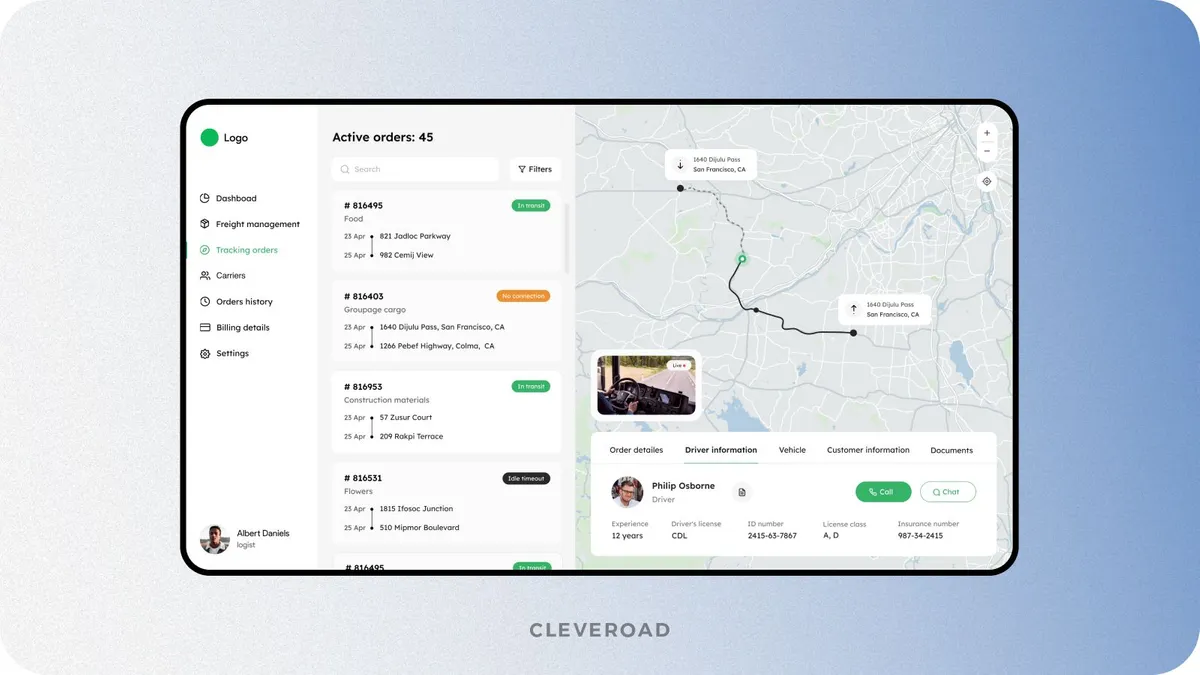
Transportation management system created by Cleveroad
4. KPIs monitoring
Even after your transportation management system’s launch, it’s vital to ensure it still meets your requirements, operates efficiently, and generally functions accurately. The vendor’s team will be your best helper, so staying in touch with them is crucial even after the solution launch. Regular collaboration with the vendor will also help proactively address any issues and ensure optimal system performance over time.
Monitoring Key Performance Indicators (KPIs), such as timeliness, software reliability, constant data accuracy, etc., facilitate software’s prominent functioning and will contribute to continuous improvements. The transportation software must be updated and reviewed occasionally to meet evolving user needs and align with your business environment innovations.
5. Data migration (if required)
It’s essential to go through this step if you seek to switch from an outdated solution to a custom transportation management system. Firstly, defining the data scope and cleaning and validating it is necessary. Then, if needed, the mapping of old to new system fields and data format conversion.
Finally, you’ll just need to upload old data into the new TMS, check its accuracy, and briefly run the parallel system to ensure that nothing goes wrong and you’re completely switched to a new system. Be careful to minimize data loss, and use previous TMS data backup if possible.
6. Support and scalability
How to build a TMS system and make it highly adaptable and reliable? An efficient support system is a powerful tool for solving any arising questions and complexities in the context of TMS software. Also, the ongoing support and maintenance services will include the system's gradual modernization through the implementation of new functionality, the architecture upgrade, and bug fixing.
Last but not least, as the business grows, there is an increasing need to operate larger data volumes and better accomplish growing user demands. The scalability implies creating a TMS software structure that’s going to be capable of handling bigger workloads with no loss in quality of performance.
Innovation Trends to Implement Through Custom TMS Software Development
Let’s explore key trends that can drive substantial improvements in transportation management through custom TMS development.
Real-time shipping monitoring
Real-time shipping monitoring is essential for maintaining visibility throughout the transportation process. By leveraging GPS and IoT sensors, custom TMS solutions can track shipments' precise locations and provide updates on estimated delivery times.
This technology enables companies to anticipate delays, proactively manage exceptions, and improve overall customer satisfaction. Real-time monitoring also enhances security by alerting teams to unauthorized route deviations or temperature fluctuations in sensitive shipments.
3D route optimization and load planning
These technologies help maximize efficiency by visualizing routes and load arrangements in three dimensions. Advanced algorithms consider factors like road conditions, vehicle capacity, and delivery windows to generate optimal routes. Enhanced load planning helps companies minimize empty space and maximize resource usage, improving cost-effectiveness across the supply chain.
Additionally, integrating these trends with an intelligent road management system enables real-time adjustments to routes based on traffic patterns and infrastructure changes, further enhancing operational efficiency.
We can develop a load planning software with 3D route optimization as well as load planning capabilities, and integrate it with your existing TMS to streamline your supply chain operations, enhance accuracy, and improve resource utilization across your logistics network.
Need load planning software in addition to your TMS? Read our article and discover the logistics basics!
Cold chain management
A custom TMS with integrated cold chain management features can track and control temperature-sensitive shipments in real time. With advanced cold chain management, companies can ensure the quality and safety of products like food, pharmaceuticals, and chemicals.
IoT sensors monitor temperature, humidity, and other critical factors throughout transit, and automated alerts notify stakeholders if any deviation occurs. This proactive approach to transportation management software development ensures compliance with regulatory standards.
Blockchain implementation
Blockchain technology brings transparency and security to TMS by providing an immutable record of transactions and shipment history. With Blockchain, all parties involved in a shipment can access a secure, decentralized ledger that records each step in the transportation process.
This way, Blockchain in supply chain development services helps prevent data tampering, improves trust between partners, and streamlines compliance with regulations. Moreover, Blockchain is valuable for tracking complex supply chains, as it enables quick and reliable traceability from origin to destination.
Cost to Build TMS Software
The cost of TMS software development ranges between $15,000 for a simple solution and goes up to $500,000+ for a complex system with advanced functionalities. But that’s a pretty big range, right? The fact is that it’s difficult to calculate the software cost precisely, as the final price varies due to the following cost-forming aspects:
- Scope of features: Basic TMS solutions with essential functionalities, such as route planning and order management, cost less than advanced systems with real-time tracking, AI-driven analytics, and integrations with ERP or CRM systems.
- Development team structure: A larger team with specialized roles, such as solution architects, UX/UI designers, and data scientists, may increase costs but can contribute to a more scalable solution.
- Technology stack: The technologies used for building the TMS can affect the final price. For example, implementing advanced technologies like AI, blockchain, or IoT can be more costly but provide enhanced functionality and a competitive edge.
- UI/UX complexity: A well-designed, intuitive interface enhances user experience but can add to development costs. Tailoring the interface for specific workflows, role-based access, or custom dashboards can also increase the budget.
These factors collectively determine the total cost of TMS development, making it essential to plan and prioritize features that align with business goals and budget.
To simplify the task of calculating TMS costs, we’ve analyzed the software development rates in the most popular outsourcing destinations. Here, you can examine the rates of the most demanded destination, including Central and Eastern Europe (CEE) region:
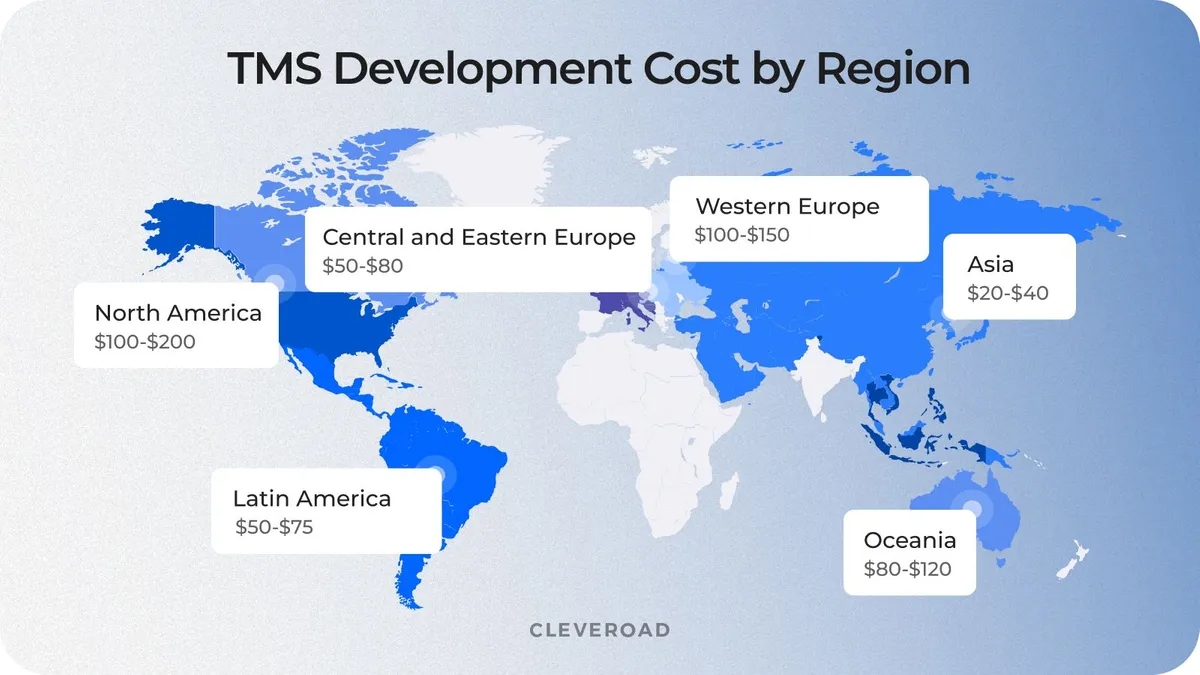
TMS Development Cost by Region
As shown, the numbers vary significantly. When considering TMS software development, the Central and Eastern Europe (CEE) region offers undeniable advantages, with a strong pool of highly skilled professionals and competitive rates compared to other markets. Estonia, in particular, stands out due to its robust tech ecosystem, high level of English proficiency, and focus on digital innovation.
By choosing developers in CEE region, you gain access to a talented workforce with expertise in logistics and transportation software, making it an ideal destination for quality-driven, cost-effective solutions. Contact us today for a customized estimate to see how we can bring your TMS vision to life.
Why Select Cleveroad for Transportation Management System Development
Cleveroad is a professional logistics software development company based in Estonia, Central Europe. Since 2011, Our experts have been assisting startups and organizations of all kinds in acquiring cutting-edge software that helps with supply chain optimization.
Our experts focus on rendering a wide variety of logistics software building services, from custom app creation and UI/UX design to legacy system modernization and third-party integrations. Our digital solutions for the logistics domain improve workflow efficiency, address business issues, and aid in the acquisition of competitive advantages.
So, what can you directly achieve, and how can you benefit while collaborating with us?
- With years of hands-on experience in the logistics sector, our team brings deep expertise in developing solutions tailored specifically for the transportation industry: fleet management software, supply chain management systems, transport management software, warehouse management applications, etc.
- We are a trustworthy logistics technology partner with certifications in both ISO 9001:2015 for quality management and ISO/IEC 27001:2013 for security of information
- 280+ in-house domain engineers ensuring constant cooperation throughout your project and removing the need for expert replacements and ensuring smooth project continuity
- Signing a Non-Disclosure Agreement (NDA) by your request to protect the uniqueness of your modern transportation management system
- Free Solution Workshop to link your business requirements for advanced TMS software to our tech implementation
Build a reliable TMS with skilled vendor
Cleveroad team will offer you assistance on creating a efficient logistics solution to address your transport business painpoints
TMS applications, or transportation management system software, are digital solutions designed to optimize and manage logistics and supply chain operations. This software provides tools for planning, executing, and tracking transportation activities like route optimization, load planning, and shipment tracking.
By integrating with an order management system, a TMS helps businesses streamline deliveries, reduce costs, and improve overall efficiency in logistics.
For effective TMS software development, you’ll have to define key project requirements, find a reliable and experienced IT vendor, and then proceed with requirements gathering. Then, you’ll have to go through the development stage with your development team and integrate it with existing business systems while monitoring the process. Finally, if you need to, you’ll have to go through the data migration process and educate carriers and stakeholders on how to utilize the completed software.
The cost of TMS development and implementation ranges between $15,000 for a simple solution and goes up to $500,000+ for an advanced complex system. However, these numbers are approximate. It’s difficult to calculate the cost precisely since the final price may vary due to the project's unique requirements.
The future of TMS lies in its integration with larger supply chain management systems, enabling businesses to manage logistics more comprehensively. Transportation management systems are primarily designed to streamline various aspects of the transportation process, from route optimization to cost control.
As cloud-based TMS solutions grow in popularity, companies will benefit from enhanced scalability, real-time data sharing, and remote access. This shift, known as a transportation management evolution, will drive more efficient and resilient logistics networks in the years to come.

Evgeniy Altynpara is a CTO and member of the Forbes Councils’ community of tech professionals. He is an expert in software development and technological entrepreneurship and has 10+years of experience in digital transformation consulting in Healthcare, FinTech, Supply Chain and Logistics
Give us your impressions about this article
Give us your impressions about this article

